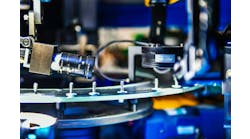New machine vision systems, components show off future of the market
Although the machine vision components and systems had their highest total ever of $2.3 billion in 2015, according to the industry’s trade group, AIA, the machine-vision category was still described as flat. Fortunately, after a quick look at some new vision hardware, lenses, lighting and software tools during the SensorSmart Machine Vision and ID Seminar in Chandler, Ariz., in early March, I'm glad to see that machine vision design improvements and innovations are increasing.
"Learning detailed information about the latest product updates in machine vision, instead of a seminar, training or lunch-and-learn works best, especially when multiple vendors are presenting," commented Ken Stumpf, president of SensorSmart Technologies, which hosted the event. "We ended up with attendees who were engineers or above and who could make decisions. It was about new designs and innovation and not just a free lunch. The format also worked well for the nine vision system and component manufacturers who each gave a half-hour presentation.”
Get your vision system vendors together and go learn something
Cognex started it off with new smart sensor cameras and 2D ID readers. With Cognex's 8000 series and 5000 series In-Sight cameras, it can boast the fastest grayscale and color 5-megapixel cameras, as well as the smallest. Faster inspection tools, such as OCR, ID read, edge and pattern find, as well as image acquisition rates, are a good thing. The inspection tools are also getting better and Java script control is now available.
Another cool thing is the liquid lenses integrated to the Cognex 7000 series cameras. Liquid lenses have been around for a few years, but the new S-mount lenses can focus on the fly when reading 2D codes on boxes traveling on a conveyor. Imagine having a focal depth of field from 4 in to 5 ft. Very useful when the box size and its position on the conveyor changes.
We can all welcome vision system lighting to the Internet of Things (IoT), as seen in some new hardware from several vendors. Advanced Illumination has a DCS-100E lighting controller that can connect via Ethernet, control three channels for RGB lighting along with Web server interface, command line tools and even a SKD to get lights turned on.
Gardasoft Technology's triniti has an intelligent lighting platform for machine vision that provides light identification, integration with image processing software and light control in a little in-line, cable-mounted chip. It allows LED controllers to automatically detect the performance characteristics and get data from triniti compatible lights—CCS and Smart Vision Lights are the initial light partners. The light also provides dynamic data related to operational performance and diagnostics—as an IoT edge device should.
To help properly deliver or receive the light, Jason Dougherty from Midwest Optical System, gave a great presentation on filters. Optical filters are the simplest and most effective way to gain control over what enters the system and is where image quality begins. Filters are no longer just an accessory in machine vision; they are now a necessity.
Filters designed for machine vision improve stability and repeatability by controlling the variability of ambient light entering the system and only allowing the optimal application illumination. They can also improve image resolution by correcting chromatic aberrations inherent with any lens and create contrast by passing or blocking specific wavelengths from reaching the camera sensor. This can greatly reduce the need to use software processing to improve image quality allowing for greater accuracy and faster speeds. Filter that a bit for better results.
Another interesting item was the telecentric lens offered by Opto Engineering. As a continuation of developing lenses for difficult applications, it has taken telecentric lenses that typically require long lenses and turned the corner, literally. It changed the opto-mechanical design of the lens, creating one that is more of a small brick or right-angle knuckle using mirrors, prisms and optics to greatly reduce the size and space needed for the physical lens.
The Opto Engineering TC Core series telecentric lens combines excellent measurement accuracy with a compact system. It's up to 70% shorter than typical solutions. It is definitely an innovative telecentric vision system lens that works well with the cameras/sensors, has many mounting options for both camera and lens and includes phase adjustment—alignment of camera sensor to object. They even have a matching illuminator. I could have used it many places in previous vision applications with approximately a 1-to-4-inch object field of view, depending on the model. Innovative stuff.
Get in touch with your vision system and component vendors. It's not just one or two vendors. There are many. These guys compete against each other, but also play well together to the benefits of machine vision as a whole. Be sure to understand the new machine vision products and benefit from the knowledge these vendors bring to vision applications.






